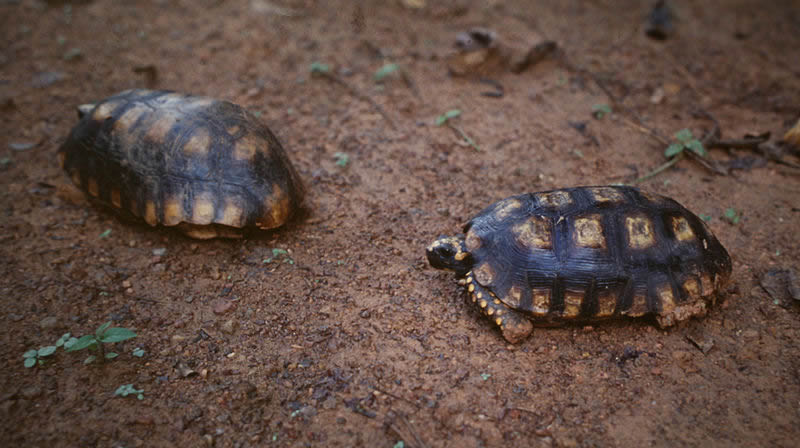There are differentiating factors in the shells of the red-footed tortoise and the Yellow-footed tortoise that helps one tell them apart.
Yellow-footed tortoises (Geochelone denticulata) are found in deep, humid rain forest areas of southern Colombia, Ecuador, Peru, Venezuela, Guyana, French Guiana, Brazil and Bolivia. They spend a great deal of time in and around water and in the leaves and undergrowth of moist tropical forests.
Although the yellow-footed tortoise is not as colorful as most red-footed tortoises (Chelonoidis carbonaria), they are still qui te beautiful. The yellow-footed tortoise is the largest tortoise on the mainland of South America. Most specimens grow to only 14 inches long, but some populat ions see individuals reaching 24 to 28 inches or more.

Photo credit: Maarten Sepp
Yellow-footed tortoise
Indoor Housing Yellow-Footed Tortoises
Yellow-footed to rtoises are not quite as hardy as red-footed tortoises. They need more shade and more stable temperatures than red-footed tortoises. Small to medium yellow-footed tortoises can be housed in tortoise tables or tubs. A hatchling enclosure should measure 2 feet by 3 feet. Larger tortoises will need an area no smaller than 8 feet by 4 feet. Depending on the to rtoise’s size, walls should be 12 to 18 inches tall.
Artificial lighting in the form of a basking lamp should be positioned to provide a hotspot of 85 to 90 degrees Fah renheit. A full-spectrum UVB lamp should also be used. This is necessary for Vitamin D syntheses. Position a hide at the cool end of the enclosure. Your tortoise will appreciate a dark, quiet retreat.
A substrate that holds moisture is essential to keeping the humidity up for this forest-dwelling species. Good choices are untreated mul ch, long-fibered sphagnum moss mixed with organic top soil, and sand or peat moss. Water areas should be large enough to allow the tortoise to easily climb into to soak. Yellow-fo oted tortoises love to soak! Keep the water depth shallow—about 1 inch deep for hatchlings and no more than 3 inches deep for adults.
Outdoor Housing for the Yellow-Footed Tortoise
In the warmer months, a secure predator-proof outdoor enclosure should be provided for your yellow-footed tortoise. Pen walls should be at least 16 inches high. Heavily planted outdoor pens with non-toxic plants will allow your tortoise the many shaded areas necessary to protect them from harsh sun rays and allow for natural grazing behavior.
The yellow-foot tortoise does not hibernate! They require a more stable environment then the red-f ooted tortoise. Temperatures in the rain forest do not change dramatically. Temperatures should not exceed 90 degrees in the day time without ample shaded areas. The nighttime tem peratures should not fall below 65 degrees. If temperatures do fall below that point, provide a heated night house or move the tortoise into an indoor pen.
Yellow-Footed Tortoise Diet
The yellow-footed tortoise is an omnivore. A healthy diet consists of leafy greens, such as chicory, e ndive, dandelions, spring mix, etc. Fruits are relished. In the wild, they eat a bit more fruit than red-footed tortoises. Some favorites are berries, melons, papaya, plums and pe aches. Animal protein should be offered no more than two to four times a month. Pinky mice and earthworms are good choices.
Red-Footed Tortoises versus Yellow-Footed Tortoises
There are differentiating factors in the shells of the red-footed tortoise and the yellow-footed tortoise that helps one tell them apart. In yellow-footed tortoises, the gular is even with the posterior portion of the carapace. In red-foots, the gular is shorter than the carapace. In the red-footed tortoise, the gulars extend back along the midline while the yellow-footed tortoise’s gular scute is longitudinally divided in the dorsal aspect, giving from the above view the appearance of four gulars. The yellow-foot’s humeral scute is longer than the femoral scute. In the red-footed tortoise, the femoral scute is usually longer than the hume ral scute. The yellow-foot’s inguinal scute is small. Red-footed tortoises have a short prefrontal nose scale and usually a large intact frontal scale. Yellow-footed tortoises hav e an elongated prefrontal scale and a fragmented frontal scale. Yellow-footed tortoise females get larger in comparison than males. In red-footed tortoises, the males get larger.

Photo credit: Flints/Wikipedia
Red-footed tortoise.
Red-footed tortoises are more elongated and slightly higher-domed, while yellow-foots display a wider and more rounded appearance. Young yellow-foote d tortoises have a denticulated first marginal scute. Young red-foots do not have this. The yellow-foot tortoise is not always as personable as the red-foot tortoises, but they ca n become quite friendly.
Like the red-footed tortoise, the yellow-footed tortoise can live for well over 50 years with proper care.
Amanda Ebenhack has kept yellow-foot tortoises for more than 12 years and is a permitted wildlife rehabilitator in Florida. She is the author of Redfoots and Yellow foots: The Natural History, Captive Care and Breeding of Chelonoidis carbonaria and Chelonoidis denticulta, as well as the author of Health Care and Rehabilitation of Turtles and Tortoises. She maintains a small private turtle and tortoise rescue and sanctuary on 5 acres. For more information see turtlerescueusa.com.

